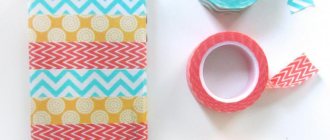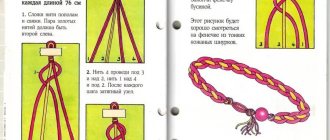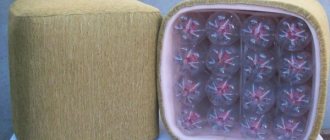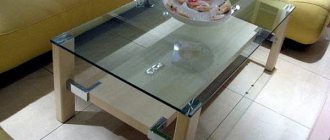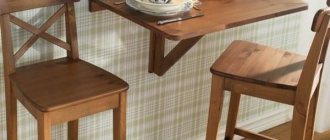In our country, this is Valentine's Day - a holiday for young people in love, and in the West it is just another reason to express love to your loved ones. A great gift idea for February 14th is a small heating pad with filling, which is easy to sew and decorate to your taste and which will warm your children, parents and loved ones both physically and mentally.
During the season of preparing gifts and before any holidays, I fall into a painful state called “handicraft dreams”. While walking around the shops, things get worse and different thoughts pop into your head. For example: “Hey, I can do this in five minutes and only spend 50 cents,” or “Not bad, not bad, but it would look cooler with a larger and hand-embroidered monogram,” or “So what if I've never knitted socks before? I will buy 20 skeins of yarn. What’s so complicated about that?” Always like this!
Rice or salt hand warmers: 6 ideas with instructions
Photo: thisgrandmaisfun.com
As a rule, such heating pads are made small in size - about the size of a palm or a little less. It is better to sew them from thick fabric. Inside is rice or coarse salt. Such a heating pad can be heated in the microwave in 15-30 seconds (be careful not to get burned - the heating strength depends on the power of the microwave) or even on a fairly well-functioning battery, then the heating pad will have an optimal, not too hot temperature. When going out into the cold, you can put the heating pad in a mitten or put it in your pocket, and it will warm your hands. Salt and rice retain heat for quite a long time, cooling slowly. You can make a heating pad quite simple by sewing a bag and pouring filling, or you can come up with something more interesting. Here are some options for heating pads.
Second chance: hat, mittens and snood scarf from a pullover
Simple heating bags
These warmers are made of plain cotton and filled with rice. Cut out an even number of rectangles measuring 8x9 cm. Fold two at a time, face inward, and sew around the perimeter, leaving an opening. Turn out, fill with rice and sew the holes closed with a blind stitch.
Photo and source: vanessachristenson.com
How to sew mittens with your own hands
Felt heating pad, hand-sewn and decorated with cross stitch
This heating pad is sewn from a single piece. In this case, felt was used. The size of the part is 10x15 cm. First, embroider in the middle of the part. Then hand stitch the middle seam. Then - one of the side ones. Fill a hot water bottle with rice or salt and sew the remaining side seam.
Photo and source: wildolive.blogspot.com
How to sew a zippered mitten muff for a baby stroller
Warmers using patchwork technique
An option for those who love patchwork or are just starting to learn patchwork, this is a simple project that allows beginners to practice. We cut out right triangles with a leg length of 8 cm + 1 cm seam allowances. For each heating pad you need 4 of these rectangles. We sew the triangles together 2 at a time to make a square, and press the seams. We fold two squares face inward, sew them around the perimeter, leaving a hole, cut off the corners, turn them inside out, iron them, and fill them with rice or salt. We sew the hole by machine.
Photo and source: redhandledscissors.com
DIY fashionable thermal cover in patchwork style
Heart-shaped heating pads
Warmers can also be made in the shape of hearts. The procedure is essentially the same as in the first master class, only you need to cut out not rectangular parts, but, accordingly, heart-shaped parts.
Photo and source: haberdasheryfun.com
How to sew knitted mittens with your own hands
The simplest heating pads made from fabric that does not fray
These warmers can be made from fabric that doesn't fray too much, such as flannel. You will also need zigzag scissors. Cut out two identical squares, pin them together and trim the edges with curly scissors. With the wrong sides facing in, sew around the perimeter, leaving an opening. Fill with rice and sew up the hole.
Photo and source: thechildatheartblog.com
DIY toys: little friends
Warmers in the form of animals or birds
You can also make warmers in the shape of simple characters, for example, in the shape of owls. Draw the templates yourself or find patterns on the Internet for the simplest felt toys. Patterns of parts for these owl warmers can be downloaded here. The easiest way to sew such warmer toys is from felt or felt. First, complete the front side, sewing all the parts, then partially sew the toy around the perimeter, add rice or salt and sew up the hole.
Photo and source: repeatcrafterme.com
How to make a chemical heating pad with your own hands
When hiking, fishing, especially in bad weather, you often need an ordinary heating pad. Of course, an ordinary rubber one is not bad, but it has one significant drawback: it heats up water very slowly over a fire. Let's try to make a chemical heating pad. For this we need the most common reagents.
When hiking, fishing, especially in bad weather, you often need an ordinary heating pad. Of course, an ordinary rubber one is not bad, but it has one significant drawback: it heats up water very slowly over a fire.
Let's try to make a chemical heating pad. For this we need the most common reagents.
First, let's do a simple experiment. Go to the kitchen and take a pack of table salt. However, you won't need a pack. 20 g (2 teaspoons) will be enough. Then look into the cabinet where all kinds of household supplies and materials are stored. Surely there was some copper sulfate left there after the apartment was renovated. You will need 40 g (3 teaspoons). Wood chips and a piece of aluminum wire, presumably, will also be found. If so, you're done. Grind the vitriol and salt in a mortar so that the size of the crystals does not exceed 1 mm (by eye, of course). Add 30 g (5 tablespoons) of sawdust to the resulting mixture and mix thoroughly. Bend a piece of wire into a spiral or snake and place it in a mayonnaise jar. Pour the prepared mixture there so that the filling level is 1-1.5 cm below the neck of the jar. The heating pad is in your hands. To activate it, just pour 50 ml (a quarter cup) of water into the jar. After 3-4 minutes, the temperature of the heating pad will rise to 50-60° C.
Where does the heat in the jar come from, and what role does each component play? Let's look at the reaction equation:
CuSO4+2NaCl > Na2SO4+CuCl2
As a result of the interaction of copper sulfate with table salt, sodium sulfate and copper chloride are formed. It is she who interests us. If we calculate the heat balance of the reaction, it turns out that the formation of one gram molecule of copper chloride releases 4700 calories of heat. Plus the heat of dissolution in the initial resulting drugs - 24999 calories. Total: approximately 29,600 calories.
Immediately after formation, copper chloride interacts with aluminum wire:
2Al+3CuCl2 > 2AlCl3+3Cu
In this case, approximately 84,000 calories are released (also calculated per 1 g-mol of copper chloride).
As you can see, as a result of the process, the total amount of heat released exceeds 100,000 calories per gram-molecule of the substance. So there is no mistake or deception: the heating pad is real.
What about sawdust? Without taking any part in chemical reactions, they at the same time play a very important role. By greedily absorbing water, sawdust slows down the course of reactions and extends the operation of the heating pad over time. In addition, wood has a fairly low thermal conductivity: it seems to accumulate the generated heat and then constantly releases it. A tightly sealed container will retain heat for at least two hours.
One final note: a jar is, of course, not the best vessel for a heating pad. We only needed it for demonstration. So think about the shape and material for the tank in which to place the heating mixture.
Source: “Young Technician” magazine, No. 5, 1983, pp. 78-79. Author: engineer F. Nikulin.
December 1, 2011 at 11:35 pm
Add essential oil
Spruce / Lauren Murphy.
This step is optional, but recommended!
Research shows that lavender may be useful for treating anxiety, insomnia, depression and restlessness. It is a soothing scent that promotes calm and peace of mind. If you want to add the calming benefits of lavender to your heating pad, add a few drops (about 10) of lavender essential oil to the rice before or after you put it in your sock. Not only will the heating pad smell nice, but it will also help you relax.
Warming compress
Sometimes treatment requires longer heat exposure. Therefore, in this case, it is recommended to use a warming compress with an algorithm in several main stages. They must be strictly followed to achieve the maximum effect of therapy.
Heat therapy is most often used to treat inflammation in the ears. The warming compress algorithm consists of the following steps:
- Fold sterile cotton wool in several layers.
- Wrap gauze around the top and make a cut in the center.
- Apply the resulting compress to the ear, but make sure that the hole is on the auricle.
- Secure the bandage with a bandage, placing it over the ear.
You can also use dry heat at home to treat your lower back. For a warming compress, a bandage made of a woolen scarf or scarf is used, which is fixedly fixed on the belt.
Dry heat therapy in this case is used to delay the natural heat transfer of the body.
Features of using dry heat for babies
Experts also recommend using a salt heating pad for newborns against colic. But in this case, it is better to purchase a special device at the pharmacy, which is a sealed bag with a salt solution, which guarantees safety of use for the baby.
To heat up a dry heating pad, just press the special start button, after which the temperature begins to rise to a maximum of +54 ˚С. Before use, it should initially be wrapped in a diaper and applied to the problem area. Cooling occurs within 4 hours. After use, the heating pad should be boiled for 10 minutes.
A salt heating pad for newborns against colic helps the baby calm down and switch to distractions.
Soothes soreness
Spruce / Lauren Murphy.
Place the finished product in the microwave for about 1 minute (or less, depending on the power of your microwave). It should be warm to the touch, but not hot. Then apply it to the pain areas and get ready for ultimate relaxation! Increase your R&R ratio, light a scented candle, and play soothing music.
Prepare and fill the sock
Spruce / Lauren Murphy.
Transporting rice into a thin sock can be a difficult and sometimes frustrating process. This is where the funnel begins. Use a large funnel to easily guide the grains of rice into the sock. Fair warning is a slow process. Just keep slowly adding more and more rice until the sock is about three-quarters full. Make sure there are no metal threads in the sock that could ignite when heated in the microwave. The best material to use is 100% cotton, which fortunately is a readily available material for socks.
In what cases should it be used?
Heat therapy, like any other type of treatment, has indications for use. Therefore, in order to achieve a positive result and eliminate the possibility of a reverse effect, you should familiarize yourself with them in advance.
Dry heat at home is recommended for use in the following cases:
- chronic joint diseases;
- musculoskeletal injuries;
- bruises;
- colds, ENT diseases (otitis, inflammation of the pharynx, larynx);
- radiculitis, arthritis;
- diseases of the nervous system;
- headache, migraine;
- dystonia – to relieve muscle spasms;
- sleep disorders;
- colic in babies.
Tie a knot in your sock
Spruce / Lauren Murphy.
After filling the sock with rice to your liking, take the end and tie a secure knot. Start by wrapping the end of the sock around two fingers to create a loop. Then pull it tightly through the loop. If you've ever tied a balloon to water, use the same method. Then trim off the excess fabric with scissors.
What does dry heat mean?
The effectiveness of using thermal effects on the body in the treatment of many diseases has been confirmed long ago. But often the therapy uses the dry method of therapy, which implies creating a warming result without direct contact of moisture with the skin. This is achieved by using components that can retain heat for a long time.
An example of such therapy are various heating pads, compresses made of sand, salt, paraffin, sun rays, healing lamps and other objects that emit heat. Using dry heat at home, you can prevent the further development of the pathological process and significantly speed up recovery.
